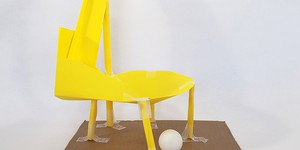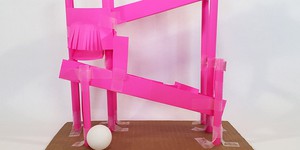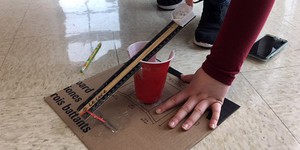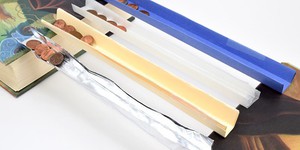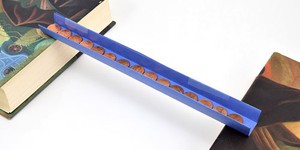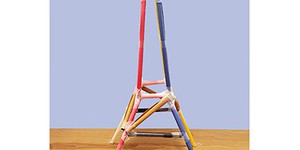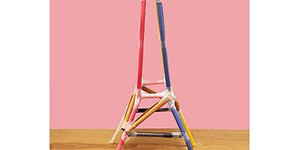Lesson Plans (251 results)
Free science lesson plans designed to engage students through hands-on experiments and activities. Chemistry, life sciences, physics, engineering and more, for elementary, middle and high school teachers.
|
Select a resource
Sort by
|
Lesson Plan
Grade: 3rd-5th
2 reviews
Add a twist to a classic activity with this fun lesson plan. Your students will design and build a ball run for a ping pong ball using nothing but paper and tape. Their goal is to make the slowest ball run possible. How long can they make it take for the ball to go through their ball run? The 2022 competition is over, but you can see what students built and learn about the winners on the 2022 Engineering Challenge summary page. Teachers, note that
middle school and
high school …
Read more
NGSS Performance Expectations:
Lesson Plan
Grade: 6th-8th
2 reviews
Add a twist to a classic activity with this fun lesson plan. Your students will design and build a ball run for a ping pong ball using nothing but paper and tape. Their goal is to make the slowest ball run possible. How long can they make it take for the ball to go through their ball run? The 2022 competition is over, but you can see what students built and learn about the winners on the 2022 Engineering Challenge summary page. Teachers, note that
elementary
and
high school
…
Read more
NGSS Performance Expectations:
Lesson Plan
Grade: 9th-12th
4 reviews
Add a twist to a classic activity with this fun lesson plan. Your students will design and build a ball run for a ping pong ball using nothing but paper and tape. Their goal is to make the slowest ball run possible. How long can they make it take for the ball to go through their ball run? The 2022 competition is over, but you can see what students built and learn about the winners on the 2022 Engineering Challenge summary page.
Teachers, note that
elementary and
middle school
…
Read more
NGSS Performance Expectations:
Lesson Plan
Grade: 6th-8th
2 reviews
Add a twist to a traditional "build a catapult" engineering project with this fun lesson plan based on the 2018 Engineering Challenge. Your students must build a device to launch a ball as far as possible—but they also have to build another device to catch it! With detailed rules and guidelines for a class-wide competition, this lesson is a great way to teach your students about the engineering design process.
Read more
NGSS Performance Expectations:
Lesson Plan
Grade: 2nd
4 reviews
Steel, concrete, wood—real bridges are built from many different materials. How do engineers decide which materials to use? In this activity, your students will expand on the previous paper bridges lesson plan by building and testing bridges made from different materials.
Read more
NGSS Performance Expectations:
New
Lesson Plan
Grade: 6th-9th
In this lesson plan, students will model the complex biologic manufacturing process. First, they will model the cellular expansion process that occurs in a bioreactor. Then, students will lyse the cells to isolate the proteins from the dyed cell debris. Lastly, they will model the advanced filtration process to purify proteins so they can be used as medicines.
Read more
NGSS Performance Expectations:
Lesson Plan
Grade: Kindergarten-2nd
19 reviews
Your students have probably walked or ridden over a bridge at some point in their lives. In this engineering activity they will design and make bridges out of folded pieces of paper, and test how much weight they can hold with pennies. How does the shape of a bridge affect its strength? Let your students explore and find out with this lesson!
This lesson can be expanded to a second lesson looking at how the material a bridge is made out of can change its strength; see second lesson for details.
Read more
NGSS Performance Expectations:
Lesson Plan
Grade: 3rd-5th
10 reviews
Teach your students about the engineering design process with this fun lesson plan. They will design and build the tallest possible tower using nothing but paper and tape, but there's an additional twist on this classic activity. The tower must support a heavy weight at the top without collapsing! Teachers, note that middle school and high school versions of this lesson plan are also available. The 2021 Engineering Challenge is over, but you can still try this fun lesson with your students,…
Read more
NGSS Performance Expectations:
Lesson Plan
Grade: 9th-12th
6 reviews
Teach your students about the engineering design process with this fun lesson plan. The lesson is based on the real-world challenge of designing an observation tower. Can your students maximize the height of the tower while minimizing the amount of material needed to construct it? Teachers, note that elementary and middle school versions of this lesson plan are also available. The 2021 Engineering Challenge is over, but you can still try out this fun challenge with your students, or check…
Read more
NGSS Performance Expectations:
Lesson Plan
Grade: 6th-8th
2 reviews
Teach your students about the engineering design process with this fun lesson plan. They will design and build the tallest possible tower using nothing but paper and tape, but there's an additional twist on this classic activity. The tower must support a heavy weight at the top without collapsing! Teachers, note that elementary and high school versions of this lesson plan are also available.
The 2021 Engineering Challenge is over, but you can still try out this fun challenge with your…
Read more
NGSS Performance Expectations:
Lesson Plan
Grade: 6th-8th
7 reviews
In this small group activity, students will build a plant seed (burr) from a Styrofoam® ball and other crafts materials. The seed needs to be designed in a way that it can be dispersed by attaching to a mockup animal (wool glove). Students will first test if their seed attaches to the wool glove and then carry their attached seed along an obstacle course inside the classroom. As students design their plant seed and mimic its dispersal via an animal, they will realize how some plants grow…
Read more
NGSS Performance Expectations:
|



